There are various ways to categorize the different types of biblical sermons. To keep it super simple, I will categorize them into four types: 1) Expository Sermons; 2) Textual Sermons; 3) Topical Sermons; and 4) Narrative sermons.
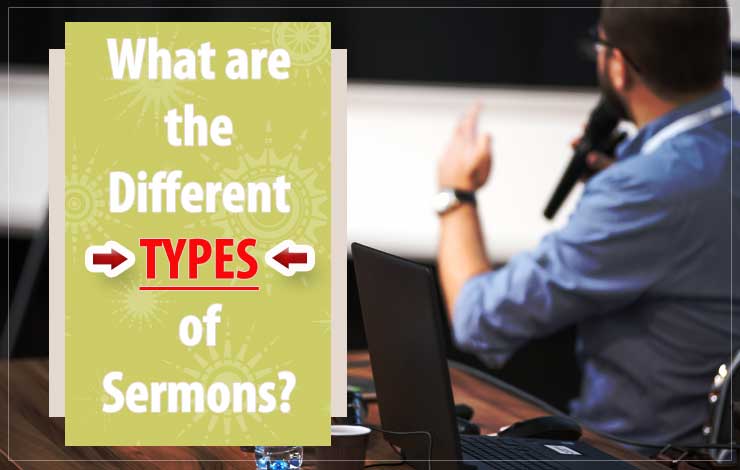
What are the different types of sermons?
- Expository Sermons
- Textual Sermons
- Topical Sermons
- Narrative Sermons
Again, I want to categorize the different types of biblical sermons into four types: expository, textual, topical and narrative.
In this article, I want to explain each category and then I want to expand on the explanation by giving an example of each category.
This will help the reader to understand the meaning of the four types of biblical sermons and how they are formed in order to preach them to an audience.
1. Expository Sermons
An expository sermon is a sermon that comes from a passage of Scripture that has one subject or theme.
For example, you may be preaching through the book of Hebrews. When you come to Hebrews 4:14-16, you discover that this passage of Scripture forms a great sermon on Jesus’ role as counselor. I will use this passage as an example of an expository sermon (see below).
The bulk of the information for an expository sermon comes directly from the passage of Scripture. The expository outline is drawn directly from the passage of Scripture and will consist of a series of progressive ideas following from the one main idea or topic (see example below).
2. Textual Sermons
A textual sermon is a sermon that is developed from a verse or verses of Scripture in order to preach a certain topic to the audience.
For example, you may want to preach the importance of God’s word in the life of the Church and in the life of individual Christians. You discover that 2 Timothy 3:16-17 has all the material you need to achieve your goal. I will use this example to illustrate a textual sermon (see below)
The verse or verses of Scripture will provide the theme or main preaching point of the textual sermon.
3. Topical Sermons
A topical sermon is a sermon that derives its topic or main preaching point independent of the text of Scripture.
In other words, you form a topical outline and you garner Scripture verses to support the preaching points of the topical sermon outline.
For example, you may decide to share with the audience different ways we can share God’s love with others. You develop a topical sermon outline around various Scripture verses in the Bible (see below for example).
I generally preach books of the Bible and these messages are expository in nature. However, I have developed topical sermons from the huge reservoir of expository sermons that I have preached in order to share messages on special occasions like father’s day, mother’s day, Easter, Christmas, child dedication or baptism. Sometimes I want to preach on individual topics like faith, heaven, hell, rapture, tribulation, forgiveness, acceptance, justification, sanctification, etc. etc. The topical sermon enables you to do this.
4. Narrative Sermons
A narrative sermon is a sermon that develops a sermon outline with loosely associated ideas that narrow down to a single idea in order to present an important message.
Narrative sermons are generally presented using an inductive method to structure the sermon outline.
I will use the inductive method to illustrate the narrative sermon. In fact, I will give a couple of examples (see below).
5. Expository Sermons Explained
The best way to explain an expository sermon is by example. I will use Hebrews 4:14-16 as an example.
“(14) Seeing then that we have a great High Priest who has passed through the heavens, Jesus the Son of God, let us hold fast our confession. (15) For we do not have a High Priest who cannot sympathize with our weaknesses, but was in all points tempted as we are, yet without sin. (16) Let us therefore come boldly to the throne of grace, that we may obtain mercy and find grace to help in times of need.”
The expository sermon draws it main divisions from the text of Scripture. In this passage of Scripture, I noticed three main divisions: He is our great High Priest (4:14). He is our sympathetic High Priest (4:15) and He is our merciful and gracious high priest (4:16).
The overall theme of the passage or the main preaching point of the passage was the nature of Jesus as our High Priest, that is, Jesus is our great counselor.
Therefore, I developed the main preaching point as: There are three reasons why we can come to Jesus for counsel. The full expository sermon outline is below.
Introduction:
There are three REASONS why we can come to Jesus for counsel. They are:
1. He is our great High Priest (4:14)
- He purged our sins (1:3)
- He is the exalted one (4:14a)
- He is our perfect mediator (4:14b)
- He is the object of our confession (4:14c)
2. He is our sympathetic High Priest (4:15)
- He endured many trials and testings (4:15a)
- He triumphantly endured these trials and testings (4:15b)
3. He is our merciful and gracious High Priest (4:16)
- We can come to Jesus with confidence (4:16a)
- We can come to Jesus for help in all situations (4:16b)
Conclusion:
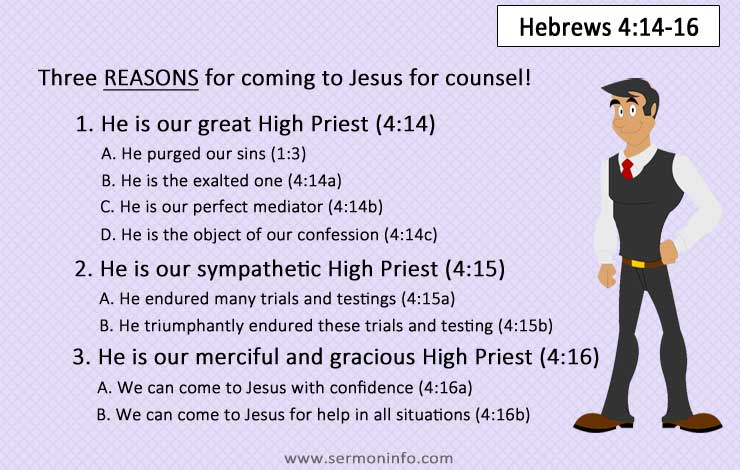
Another example of an expository sermon is from 2 Peter 2:1-3.
“(1) But there were also false prophets among the people, even as there will be false teachers among you, who will secretly bring in destructive heresies, even denying the Lord who bought them, and bring on themselves a swift destruction. (2) And many will follow their destructive ways, because of whom the way of truth will be blasphemed. (3) By coveteousness they will exploit you with deceptive words; for a long time their judgement has not been idle, and their destruction does not slumber.”
The main preaching point of the passage is false prophets and false teachers. Peter as his readers to be aware of them because they are workers of evil.
Here is the full expository sermon outline of 2 Peter 2:1-3!
Introduction:
There are three REASONS why we need to be aware of false teachers and workers of evil. They are:
1. They seek to distort the truth (2:1)
- They distort the truth secretly (2:1a)
- They distort the truth through denial (2:1b)
2. They seek to draw a following (2:2)
- They lead you to unholy living (2:2a)
- They lead you to discredit the truth (2:2b)
3. They seek to exploit for personal gain (2:3)
- They seek power, privilege and position (2:3a)
- They peddle cleverly made-up stories (2:3b)
Conclusion:
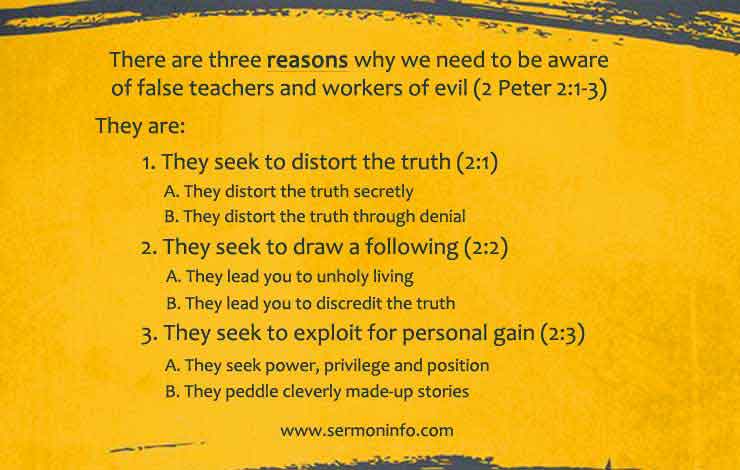
6. Textual Sermons Explained
I would suggest that a textual sermon is very similar to an expository sermon. However, the textual sermon takes one or two verses of Scripture in order to preach a subject or theme to an audience.
The textual sermon derives its information from the Scripture verse or verses under examination.
The example that I will use is from 2 Timothy 3:16-17.
“(16) All Scripture is given by inspiration of God, and is profitable for doctrine, for reproof, for correction, for instruction in righteousness, (17) that the man of God may be complete, thoroughly equipped for every good work.”
The main preaching point of these verses is power of God’s word. God’s word is inspired (16a), God’s word is profitable (16b) and God’s word is dependable (17).
This is the sermon outline that I crafted for this textual sermon.
Introduction:
There are three REASONS why we need to embrace the power of God’s word. They are:
1. God’s word is inspired (3:16a)
- It pierces the heart (Acts 2:37)
- It reveals the heart (Hebrews 4:12)
2. God’s word is profitable (3:16b)
- It establishes a right belief (3:16c)
- It establishes a right behaviour (3:16d)
3. God’s word is dependable (3:17)
- It brings you to maturity (3:17a)
- It equips you for ministry (3:17b)
Conclusion:
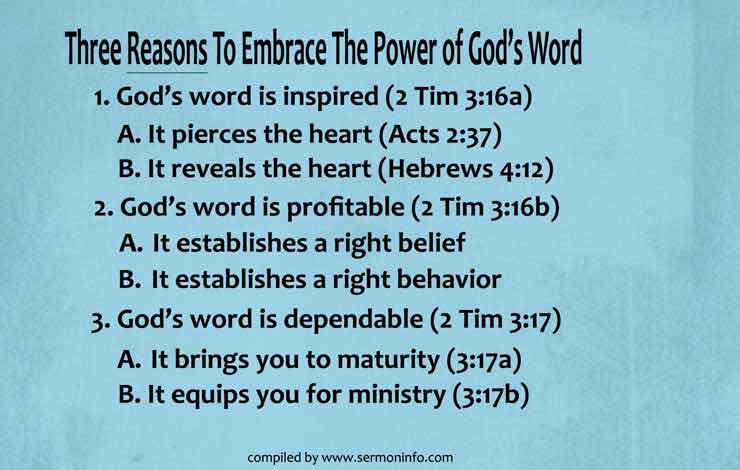
Another example of a textual sermon is John 3:16.
When you block diagram John 3:16, you will notice three distinctive points (see image below). Block diagramming is also often called “The Mechanical Layout of the Scriptures.”
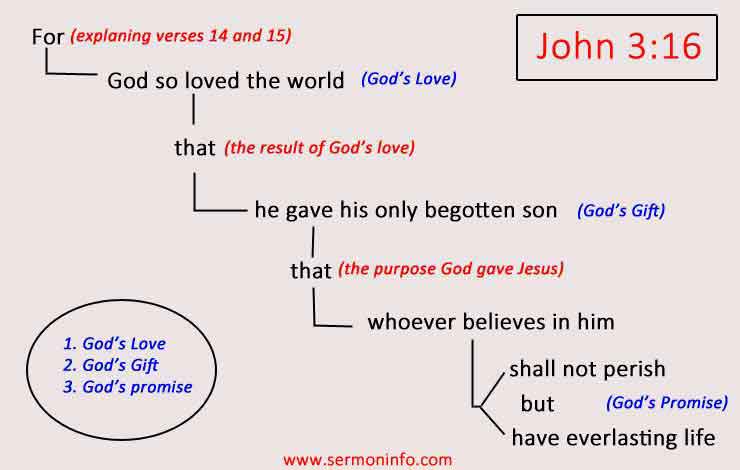
The block diagram of John 3:16 clearly demonstrate a natural textual outline for a sermon outline.
I found the main preaching point to be the greatness of God. So I decided to draw three magnificent pictures of God’s greatness. Here is the sermon outline below!
Introduction:
There are three magnificent PICTURES of the greatness of God in John 3:16. They are:
1. The Greatness of His Love (3:16a)
- His love is for all people
- His heart is that all people hear the gospel
2. The Greatness of His Sacrifice (3:16b)
- His son died for you
- His son bore sin’s penalty on your behalf
3. The Greatness of His Promises (3:16c)
- You have forgiveness of sin
- You have eternal life
Conclusion:
7. Topical Sermons Explained
A topical sermon is a sermon that is formed around a biblical subject like: temptation, forgiveness, giving, heaven, hell, sin or love.
A topical sermon is one way to drill down into a subject so that the audience will understand the biblical meaning behind these subjects like temptation or forgiveness.
The topical sermon that I want to give as an example is a sermon that I crafted from reading a book on the topic of God’s love.
I decided to call the topical sermon: “How to Share God’s Love With Others?”
Here is the sermon outline in full!
Introduction:
There are four WAYS we can share God’s love with others. They involve:
1. Tender Love (Ephesians 4:32)
- Tender love is difficult sometimes
- Tender love is doing what Jesus did
2. Tough Love (Matthew 23:23ff)
- Tough love is difficult also
- Tough love is being firm but sensitive
3. Sacrificial Love (1 John 3:16)
- Sacrificial love costs
- Sacrificial love is about giving of self
4. Radical Love (Matthew 5:39-41)
- Radical love does not retaliate
- Radical love goes beyond legal rights
- Radical love goes the second mile
Conclusion:
As you can see, the topical sermon is crafted around a biblical subject and expands and explains that biblical subject with several different points. The Scriptures are used to proof text those points.
8. Narrative Sermons Explained
Again the narrative sermon develops its outline by pulling together loosely associated ideas with the goal to narrow down to a single idea in order to present an important message.
Narrative sermons are great for narrative genre or the biblical stories in the bible which often have a single idea to present.
Also narrative sermons are great because they take the audience on a journey to an important biblical truth.
There are different ways to form a narrative sermon. The two most popular ways come from “The Homiletical Plot” by Eugene Lowry. It often referred to as Lowry’s Loop. The other popular ways is associated with Andy Stanley’s book: “Communicating For a Change!”
I will give an example of both of these methods to form narrative outlines in order to preach narrative sermons.
I will start with Andy Stanley’s method of narrative preaching – also known as inductive preaching.
Here is an overview of Stanley’s Structure!
ME – Here is a problem I have or have had
WE – Here is how this affects all of us
GOD – Here is what God says about this problem
YOU Here is what you should do
WE Here is what would happen if we all did this
Here is a tentative narrative outline using Stanley’s method of 2 Timothy 3:16-17.
1. I live in a noisy world of competing voices (ME)
2. We are constantly told what to do and how to live (WE)
3. And yet, God speaks loud and clear (GOD)
- His words are powerful (3:16a)
- His words are profitable (3:16b)
- His words are dependable (3:17)
4. You need to hear God’s voice above all others (YOU)
5. Just imagine the impact if we did that! (WE)
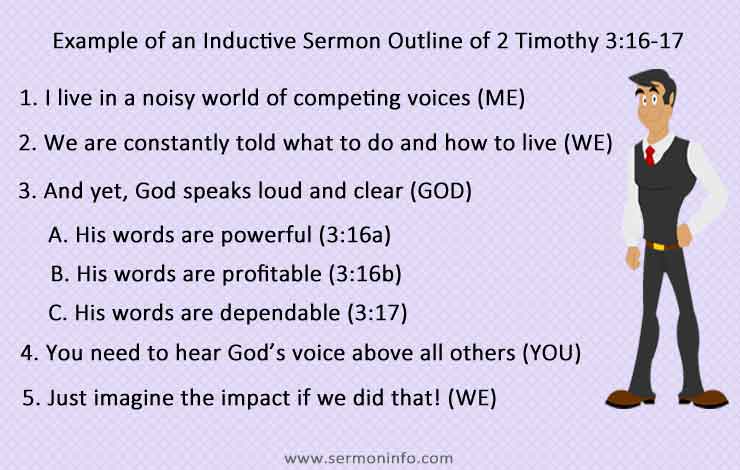
Let me share an example of Eugene Lowry’s method of narrative preaching by using his method of outlining a narrative sermon.
OOPS – Upsetting the Equilibrium
UGH – Analyzing the Discrepancy
AHA – Disclosing the Clue to Resolution
WHEE – Experiencing the Gospel
YEAH – Anticipating the Consequences
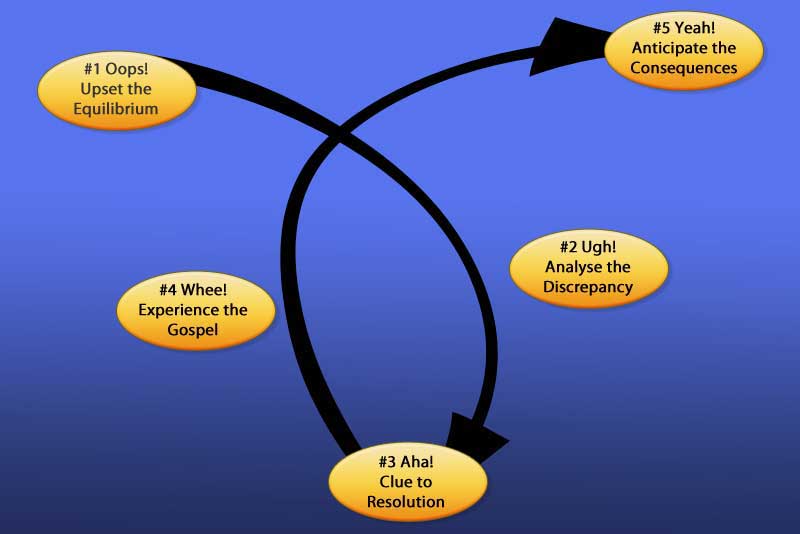
Here is an example of a narrative sermon outline from 2 Peter 1:1-4 using Lowry’s Loop as the model.
1. The world is falling apart (OOPS)
2. And the church is crumbling around us (UGH)
3. But we can turn it around with spiritual growth (AHA)
4. In fact, spiritual growth is God’s key for turning it around (WHEE)
- It begins with the path of faith (1:1)
- It continues with the provision of power (1:3)
- It is maintained with the promise of enablement (1:4)
5. Let’s grow spiritually and make a difference in the church and in the world (YEAH)
9. Some Resources Used for This Article
1. How to write an inductive sermon – click here
2. How to block diagram scripture – click here
3. How to write a deductive sermon – click here
4. Mechanical layout of Scripture – click here
5. How do you make an outline for a sermon – click here
6. How to write expository sermon outlines for beginners – click here
7. 10 best books on biblical preaching – click here